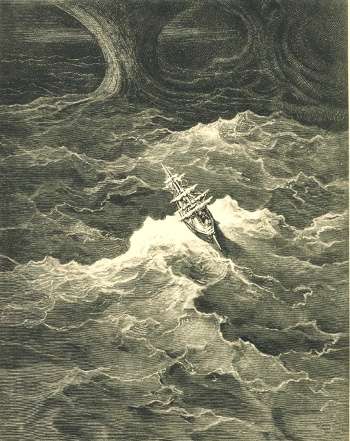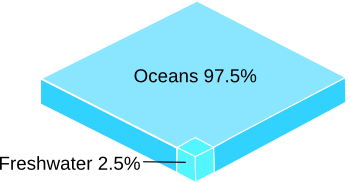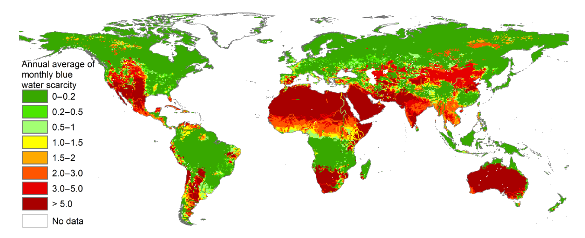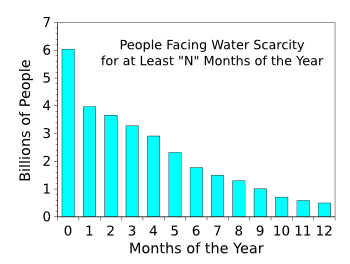Future Water Scarcity
March 28, 2016
English poet,
Samuel Taylor Coleridge, is known for his 1798
epic poem,
The Rime of the Ancient Mariner. In that poem, we read the memorable lines,
Water, water, everywhere,
And all the boards did shrink;
Water, water, everywhere,
Nor any drop to drink.
In that verse, Coleridge expresses the idea that
seawater, which is quite plentiful on
Earth, is not
potable.
Humans need
fresh water to survive. While
Darwin's "
warm little pond" may have been salty, indeed,
land animals need a constant supply of fresh water. I wrote about practical aspects of water supply in previous articles (
Virtual Water in the Roman Empire, January 22, 2015,
Virtual Water, March 4, 2013,
Fog Water Harvesting, December 2, 2010, and
The Water Equivalent of Energy, June 1, 2010).

Gustav Doré illustration from an 1866 German edition of The Rime of the Ancient Mariner by Samuel Taylor Coleridge.
According to the poem, the Mariner's ship was driven to Antarctica by a storm. At that time, Antarctica was a place so foreign that it might as well have been the Moon.
(Via Wikimedia Commons.)
Indeed,
adult humans are more than half water by
weight, while nearly three-quarters of an
infant is water. In
hot climates, a human needs to consume
gallons of water each day to survive. Increased
industrial activity, especially in
developing countries, has led to significant
pollution of water sources. Presently, billions of people in the world do not have access to safe drinking water. Two recent articles in the
scientific literature have
quantified the growing problem of global water shortfall.[1-4]

The Earth has a lot of water, but most of it is seawater.
(Adapted from figure 4.1 of ref. 5, rendered using Inkscape.)[5])
One article by
scientists at the
Twente Water Centre of the
University of Twente (Enschede, the Netherlands) concludes that previous
estimates have underestimated water scarcity by failing to measure
seasonal fluctuations in water consumption and availability.[1-2] According to those estimates, about 2-3 billion people were affected by water scarcity, but as
Arjen Hoekstra, University of Twente
Professor of
Water Management and co-author of this recent study in
Science Advances,[1] says
"Previous research looked at the availability of water on an annual basis, but that paints a more rosy and misleading picture, because water scarcity occurs during the dry period of the year."[2]

Annual average monthly potable water scarcity worldwide for the period 1996–2005. (Fig. 2 of ref. 1.[1] Click for larger image. Published under a Creative Commons Attribution-NonCommercial license.)
If you look at
averages of
monthly availability, rather than annual averages, four billion people, which is two-thirds of the
global population, experience severe water scarcity at least 1 month of the year.[1-2] For half a billion people, such scarcity extends over the entire year.[1] Particularly affected are populations in
Mexico,
northern and
southern Africa,
southern Europe, the
Middle East,
India,
China,
Australia, and the
western United States.[2] As Hoekstra explains,
"Groundwater levels are falling, lakes are drying up, less water is flowing in rivers, and water supplies for industry and farmers are threatened... The fact that the scarcity of water is being regarded as a global problem is confirmed by our research. For some time now, the World Economic Forum has placed the world water crisis in the top three of global problems, alongside climate change and terrorism."[2]

Global water scarcity by month.
Billions of people experience water shortages for a large fraction of the year.
(Graphed with Gnumeric from data in ref. 1.[1]
In another (48-page) paper, published in
Geoscientific Model Development, an international team has
modeled projected global water use in this
century.[3-4] Team participants were from
Utrecht University (Utrecht, The Netherlands),
NASA's Goddard Institute for Space Studies (New York, NY),
Columbia University (New York, NY), the
University of Kassel (Kassel, Germany), the
National Institute for Environmental Studies (Tsukuba, Japan), the
International Institute for Applied Systems Analysis (Laxenburg, Austria), the
Wageningen University and Research Centre (Wageningen, the Netherlands), and the
International Food Policy Research Institute (Washington, D.C.).
Increased water demand for
agriculture, and an enhanced
standard of living in the world, have resulted in a six-fold increase in water use in the last hundred years, and water demand continues to grow.[3] The present study predicts that water demand will at least double by 2050.[4] This modeling initiative, started in 2012, is called the
Water Futures and Solutions (WFaS) initiative, and it's a multi-year
interdisciplinary research project looking into global water issues.[4] The model incorporates climate projections of the
Intergovernmental Panel on Climate Change.[4]

Projected average domestic water withdrawals for the years 2010 and 2050. (Fig. 6 of ref. 3.[3] Click for larger image. Published under a Creative Commons Attribution 3.0 license.)
Says
Yoshihide Wada, a study
co-author at Utrecht University in the Netherlands,
"Our current water use habits increase the risk of being unable to maintain sustainable food production and economic development for the future generation... We need strong social, financial, and political commitments to reduce future water use... Our multi-model framework also provides a possible range of future water use. This can be used to develop different types of management and policy options that are needed to understand the extent of water resource challenges faced around the world... If we invest more to improve water use efficiency and water saving, we could substantially reduce and potentially stabilize future water use by 2050."[4]
References:
- Mesfin M. Mekonnen and Arjen Y. Hoekstra, "Four billion people facing severe water scarcity," Science Advances, vol. 2, no. 2 (February 12, 2016), Article no. e1500323, DOI: 10.1126/sciadv.1500323. This is an open access publication with a PDF file available here.
- Four billion people affected by severe water scarcity, University of Twente Press Release, February 13, 2016.
- Y. Wada, M. Flörke, N. Hanasaki, S. Eisner, G. Fischer, S. Tramberend, Y. Satoh, M. T. H. van Vliet, P. Yillia, C. Ringler, P. Burek, and D. Wiberg, "Modeling global water use for the 21st century: the Water Futures and Solutions (WFaS) initiative and its approaches," Geosci. Model Dev. , vol. 9 (January 21, 2016), pp. 175-222, doi:10.5194/gmd-9-175-2016. This is an open access publication with a PDF file available here.
- Pressure building on global water supply, International Institute for Applied Systems Analysis Press Release, January 25, 2016.
- Russell Arthurton, et al., Chapter 4 - "Water" from Global Environmental Outlook - GEO4 environment for development, United Nations Environment Programme, 2007 (23.5 MB PDF file).
Permanent Link to this article
Linked Keywords: English; poet; Samuel Taylor Coleridge; epic poem; The Rime of the Ancient Mariner; seawater; Earth; drinking water; potable water; human; fresh water; Charles Darwin; abiogenesis; warm little pond; terrestrial animal; land animal; Gustav Doré; illustration; German; poetry; poem; Antarctica; storm; Moon; Wikimedia Commons; adult human; weight; infant; desert climate; hot climate; gallon; industry; industrial; developing country; water pollution; pollution of water sources; scientific literature; quantification; quantify; seawater; Inkscape; scientist; Twente Water Centre; University of Twente (Enschede, the Netherlands); estimate; seasonal; Arjen Hoekstra; professor; water management; Science Advances; research; annual; monthly; Creative Commons Attribution-NonCommercial license; average; world population; global population; Mexico; North Africa; Southern Africa; Southern Europe; Middle East; India; China; Australia; Western United States; groundwater; lake; river; industry; farmer; World Economic Forum; climate change; terrorism; Gnumeric; Geoscientific Model Development; computer simulation; model; century; Utrecht University (Utrecht, The Netherlands); NASA's Goddard Institute for Space Studies (New York, NY); Columbia University (New York, NY); University of Kassel (Kassel, Germany); National Institute for Environmental Studies (Tsukuba, Japan); International Institute for Applied Systems Analysis (Laxenburg, Austria); Wageningen University and Research Centre (Wageningen, the Netherlands); International Food Policy Research Institute (Washington, D.C.); agriculture; standard of living; Water Futures and Solutions (WFaS); interdisciplinarity; interdisciplinary; Intergovernmental Panel on Climate Change; Creative Commons Attribution 3.0 license; Yoshihide Wada; co-author; habit; food industry; food production; economic development; society; social; finance; financial; politics; political; management; policy; efficiency.